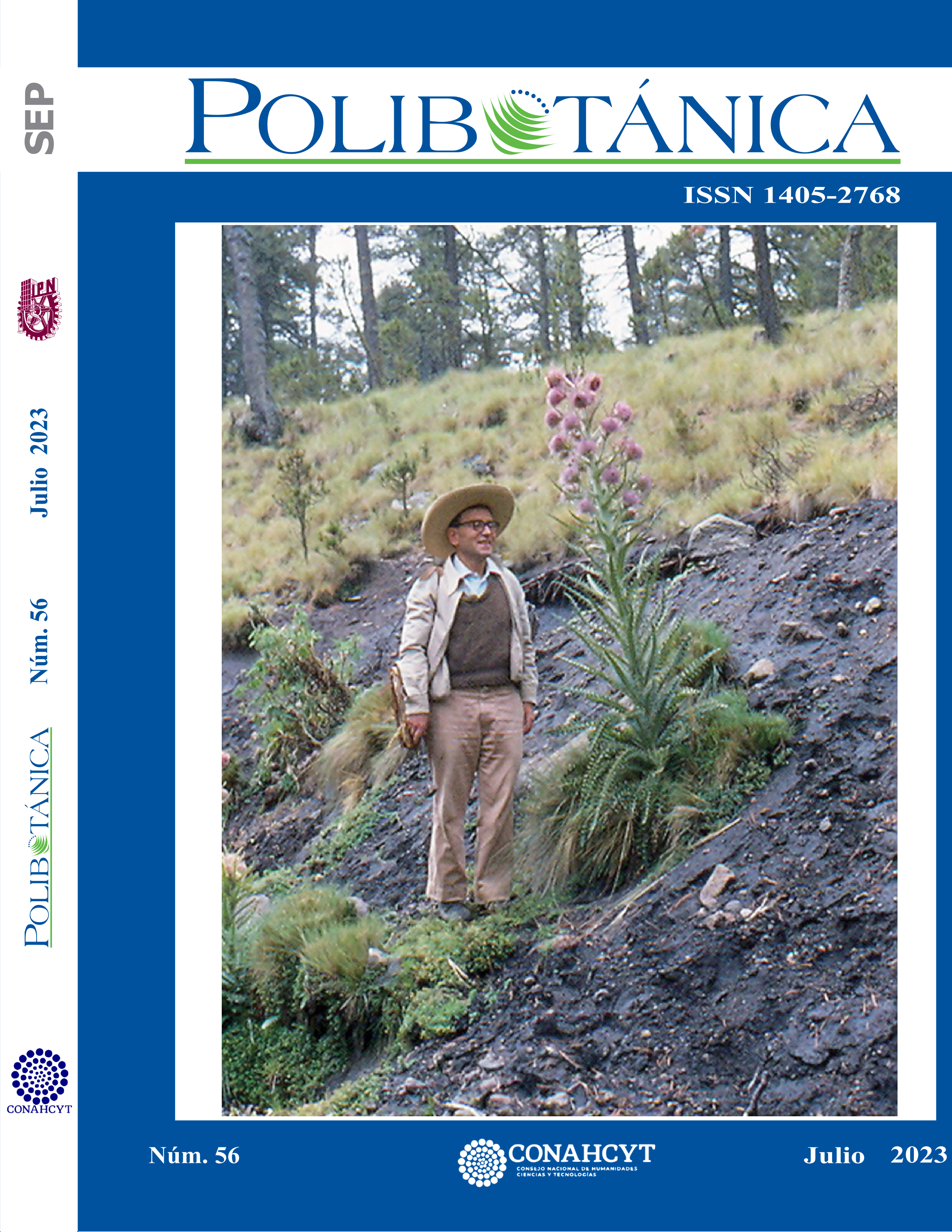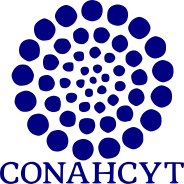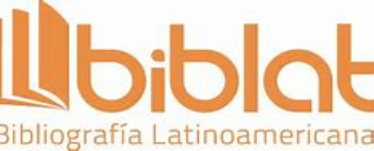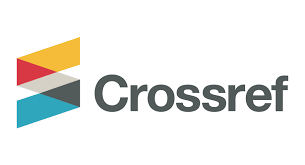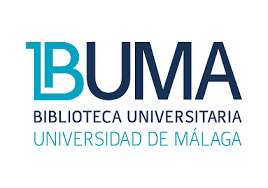Composición química, actividad antioxidante, antiinflamatoria y antiproliferativa del extracto de callos derivado de Acalypha californica Bentham
DOI:
https://doi.org/10.18387/polibotanica.56.11Palabras clave:
Acalypha californica, Cancer, Phytochemicals, Callus cultureResumen
Acalypha californica es un arbusto semileñoso utilizado por los grupos étnicos de Sonora para tratar el cáncer, debido a la presencia de fitoquímicos pertenecientes en su mayoría al grupo de los compuestos fenólicos. La premisa de este trabajo fue llevar a cabo la producción de callos a partir de hojas, pecíolos, yemas y segmentos nodales de A. californica en medio WPM suplementado con diferentes concentraciones de ácido indol butírico (AIB), bencil amino purina (BAP) y cinetina (CIN), así como la identificación de los compuestos fenólicos presentes en el extracto etanólico de callos de A. californica mediante la técnica HPLC-ESI-IT-MS-MS. La actividad antioxidante se evaluó empleando los ensayos DPPH, FRAP y midiendo el contenido de fenoles y flavonoides totales (TPC y TFC); la actividad antiproliferativa se determinó mediante el ensayo MTT en las líneas celulares cancerosas humanas A549, HeLa y MCF-7 y finalmente la actividad antiinflamatoria fue estimada a través de la capacidad inhibitoria del óxido nítrico en macrófagos RAW264.7 estimulados con LPS. Resultando que las yemas fueron el explante más callogénico, con un 55.60 % de inducción en la concentración de 1.5 mg/L de AIB, el mayor crecimiento promedio de callos se observó en hojas con un valor de 3.20 cm en la concentración de 1.0 mg/L de BAP. Los resultados mostraron que el extracto etanólico de callos de A. californica presentó una actividad antioxidante significativa con 44.85±1.22 mg/mL, 1.58±0.15 mM de Fe2+, 2.6±0.25 mM GAE y 1.56±0.25 mM QE para DPPH, FRAP, TPC y TFC respectivamente. El extracto exhibió una inhibición de la viabilidad celular del 34% en células A549 a 200 µg/mL.
Referencias
Asuzu, P. C., Trompeter, N. S., Cooper, C. R., Besong, S. A., & Aryee, A. N. A. (2022). Cell Culture-Based Assessment of Toxicity and Therapeutics of Phytochemical Antioxidants. In Molecules (Vol. 27, Issue 3). MDPI. https://doi.org/10.3390/molecules27031087
Avinash Prakasha & S Umesha. (2018). Effect of growth hormones in induction of callus, antioxidants, and antibacterial activity in Nerium odorum. Journal of Applied Biology & Biotechnology, 21–25. https://doi.org/10.7324/jabb.2018.60404
Babich, O., Sukhikh, S., Pungin, A., Astahova, L., Chupakhin, E., Belova, D., Prosekov, A., & Ivanova, S. (2021). Evaluation of the conditions for the cultivation of callus cultures of hyssopus officinalis regarding the yield of polyphenolic compounds. Plants, 10(5). https://doi.org/10.3390/plants10050915
Chinnadurai, V., Kalimuthu, K., Prabakaran, R., & Juliet, Y. (2016). Antiangiogenesis and Anticancer Activity of Leaf and Leaf Callus Extracts from Baccharoides anthelmintica (L.) Moench (Asteraceae). British Journal of Pharmaceutical Research, 13(5), 1–9. https://doi.org/10.9734/bjpr/2016/28758
de Queiroz Braga, K., Coimbra, M. C., Hortência, A., & Castro, F. (2015). In vitro germination, callus induction and phenolic compounds contents from Pyrostegia venusta (Ker Gawl.) Miers. Acta Scientiarum. Biological Sciences Maringá, 37(2), 151–158. https://doi.org/10.4025/actascibiolsci.v37i2
De-Souza, R., Adams, C. R., De-Melo, R. C., Guidolin, A. F., Michel, A., & Coimbra, J. L. M. (2022). Growth regulators and their reflection on different hop genotypes cultivated under in vitro conditions. Brazilian Journal of Biology, 82. https://doi.org/10.1590/1519-6984.242596
Din, W. M., Chu, J., Clarke, G., Jin, K. T., Bradshaw, T. D., Fry, J. R., & Wiart, C. (2013). Antioxidant and Cytoprotective Effects of an Ethanol Extract of Acalypha wilkesiana var. macafeana from Malaysia.
Efferth, T. (2019). Biotechnology Applications of Plant Callus Cultures. In Engineering (Vol. 5, Issue 1, pp. 50–59). Elsevier Ltd. https://doi.org/10.1016/j.eng.2018.11.006
Espinosa, A., Silva, J., Sariego, S., Cholo Masapanta, L., & Delgado, H. (2012). Effect of explant type and concentration of 2,4-dichlorophenoxyacetic acid on callus formation in Morus alba L (Vol. 35, Issue 4).
GLOBOCAN. (2020). World. The global cancer observatory.
INEGI. (2021). COMUNICADO DE PRENSA NÚM. 600. ESTADÍSTICAS DE DEFUNCIONES REGISTRADAS 2021.: https://www.gob.mx/cms/uploads/attachment/file/614743/sem53.pdf
Islam, A. T. M. R., & Alam, M. F. (2018). In vitro callus induction and indirect organogenesis of Mentha piperita (L.) - an aromatic medicinal plant. GSC Biological and Pharmaceutical Sciences, 4(3), 049–060. https://doi.org/10.30574/gscbps.2018.4.3.0078
Jafari, S., Daneshvar, M. H., Salmi, M. S., & Jalal-Abadi, A. L. (2017). Indirect Organogenesis and Plant Regeneration in Common Sage (Salvia officinalis L.): An Important Medicinal Plant of Iran. Modern Applied Science, 11(5), 22. https://doi.org/10.5539/mas.v11n5p22
Jagtap, V., Bidye, D., Kolge, P., Chaudhari, Y. K., Jagtap, V. A., Kanase, V. G., & Ansari, I. (2017). To study the in-vitro anti-inflammatory activity of Acalypha indica leaves. 650 Yogesh et al. World Journal of Pharmaceutical Research, 6(2). https://doi.org/10.20959/wjpr20172-7684
Johan Steven Alcantara Cortes. (2019). Principales reguladores hormonales y sus interacciones en el crecimiento vegetal Main hormonal regulators and their interactions in plant growth. NOVA, 17(32), 109–129.
Kamarul-Zaman, M. A. K., Azzeme, A. M., Ramle, I. K., Normanshah, N., Ramli, S. N., Shaharuddin, N. A., Ahmad, S., & Abdullah, S. N. A. (2020). Induction, multiplication, and evaluation of antioxidant activity of polyalthia bullata callus, a woody medicinal plant. Plants, 9(12), 1–21. https://doi.org/10.3390/plants9121772
Kargozar, S., Mollazadeh, S., Kermani, F., Webster, T. J., Nazarnezhad, S., Hamzehlou, S., & Baino, F. (2022). Hydroxyapatite Nanoparticles for Improved Cancer Theranostics. In Journal of Functional Biomaterials (Vol. 13, Issue 3). MDPI. https://doi.org/10.3390/jfb13030100
Khan, A., Shah, A. H., & Ali, N. (2021). In-vitro propagation and phytochemical profiling of a highly medicinal and endemic plant species of the Himalayan region (Saussurea costus). Scientific Reports, 11(1). https://doi.org/10.1038/s41598-021-03032-1
Krishna Sahu, R. (2016). Micropropagation and Agrobacterium: mediated transformation of GUS gene in to Gymnema sylvestre antidiabetic plants. In Journal of Medicinal Plants Studies (Vol. 18, Issue 4).
Liu, J., Osbourn, A., & Ma, P. (2015). MYB transcription factors as regulators of phenylpropanoid metabolism in plants. In Molecular Plant (Vol. 8, Issue 5, pp. 689–708). Cell Press. https://doi.org/10.1016/j.molp.2015.03.012
Lozano-Rodríguez M. A.1, M.-G. R. A. 2, A.-M. J. L. 1 y P. J. M. 1. (2015). Cultivo_in_vitro_de_yemas_axilares_de_Va. Revista Científica Biológico Agropecuaria Tuxpan, 4(6), 1153–1165.
Madlener. (2009). In vitro anti-inflammatory and anticancer activities of extracts of Acalypha alopecuroidea (Euphorbiaceae). International Journal of Oncology, 35(4). https://doi.org/10.3892/ijo_00000403
Majumder, S., & Rahman, M. M. (2016). Development of A Successful Protocol for In vitro Callus Induction and Indirect Plant Regeneration of Acalypha indica L. American International Journal of Research in Formal, Applied & Natural Sciences AIJRFANS, 16–223. http://www.iasir.net
Martínez D., M. H. R., C. A. R. B., L. F. (2007). Estandarización de un protocolo para la obtención de callos friables de borojó (Borojoa patinoi Cuatr.) fase I. Revista Colombiana de Biotecnología, 9(2), 45–55.
Mullick, A., Martin, J., & Sallnow, L. (2013). An introduction to advance care planning in practice. In BMJ (Online) (Vol. 347, Issue 7930). https://doi.org/10.1136/bmj.f6064
Nasrat, M. N., Sakimin, S. Z., & Hakiman, M. (2022). Phytochemicals and Antioxidant Activities of Conventionally Propagated Nodal Segment and In Vitro-Induced Callus of Bougainvillea glabra Choisy Using Different Solvents. Horticulturae, 8(8). https://doi.org/10.3390/horticulturae8080712
Ochatt, S., Alan, A. R., Bhattacharya, A., Hano, C., Kiselev, K. v., Marconi, P. L., Otoni, W. C., Park, S. Y., Tang, K. X., & Weathers, P. J. (2022). Secondary metabolites: a boon from plants, the best chemist in nature: preface from the editors. In Plant Cell, Tissue and Organ Culture (Vol. 149, Issues 1–2). Springer Science and Business Media B.V. https://doi.org/10.1007/s11240-022-02289-2
Patel, P., Patel, V., Modi, A., Kumar, S., & Shukla, Y. M. (2022). Phyto-factories of anti-cancer compounds: a tissue culture perspective. In Beni-Suef University Journal of Basic and Applied Sciences (Vol. 11, Issue 1). Springer Science and Business Media Deutschland GmbH. https://doi.org/10.1186/s43088-022-00203-5
Pimentel Victório, C., Borges Henriques, A., Tavares, E. S., Esquibel, M. A., Luiz, C., & Lage, S. (2010). Standardized production of Phyllanthus tenellus Roxb. by plant tissue culture 1 Produção padronizada de Phyllanthus tenellus Roxb. por cultura de tecidos vegetais. 2, 272–278. www.ccarevista.ufc.br
Purwianingsih, W., Febri, S., & Kusdianti, K. (2016). Formation flavonoid secondary metabolites in callus culture of Chrysanthemum cinerariefolium as alternative provision medicine. AIP Conference Proceedings, 1708. https://doi.org/10.1063/1.4941150
Rajkumar, V., Guha, G., & Ashok Kumar, R. (2010). Therapeutic potential of Acalypha fruticosa. Food and Chemical Toxicology, 48(6), 1709–1713. https://doi.org/10.1016/j.fct.2010.03.050
Rascón-Valenzuela, L., Jiménez-Estrada, M., Velázquez-Contreras, C., Garibay-Escobar, A., Vilegas, W., Campaner, L., Coqueiro, A., & Robles-Zepeda, R. E. (2015). Chemical composition and antiproliferative activity of Acalypha californica. Industrial Crops and Products, 69, 48–54. https://doi.org/10.1016/j.indcrop.2015.02.004
Ríos-Ramírez, S. C., Enríquez-Del Valle, J. R., Rodríguez-Ortiz, G., & Ruíz-Luna, J. (2017). Concentración de bencilaminopurina y ácido indolacético en la proliferación in vitro de brotes adventicios de agave angustifolia. In Ciencia e Investigacion Agraria (Vol. 44, Issue 3, pp. 285–294). Pontificia Universidad Catolica de Chile, Facultad de Agronomia e Ingenieria Forestal. https://doi.org/10.7764/rcia.v44i3.1810
Rippin, Sharma, A. K., & Beniwal, V. (2022). Biosynthesis and medicinal applications of proanthocyanidins: A recent update. In Biocatalysis and Agricultural Biotechnology (Vol. 45). Elsevier Ltd. https://doi.org/10.1016/j.bcab.2022.102500
Rodríguez Beraud, M. M., latsague Vidal, M. I., Chacón Fuentes, M. A., & Astorga Brevis, P. K. (2014). Inducción in vitro de callogénesis y organogénesis indirecta a partir de explantes de cotiledón, hipocótilo y hoja en Ugni molinae. Bosque, 35(1), 111–118. https://doi.org/10.4067/S0717-92002014000100011
Sagharyan, M., Ganjeali, A., Cheniany, M., & Kouhi, S. M. M. (2020). Optimization of callus induction with enhancing production of phenolic compounds production and antioxidants activity in callus cultures of nepeta binaloudensis jamzad (Lamiaceae). Iranian Journal of Biotechnology, 18(4), 47–55. https://doi.org/10.30498/IJB.2020.2621
Sampayo-Maldonado, S. (2018). CULTIVO in vitro DE RAÍCES EN MATRACES Y BIORREACTORES: ALTERNATIVAS BIOTECNOLÓGICAS PARA LA PRODUCCIÓN DE FÁRMACOS. Agro Productividad, 11(10). https://doi.org/10.32854/agrop.v11i10.1236
Sánchez-Rangel, J. C., Benavides, J., Heredia, J. B., Cisneros-Zevallos, L., & Jacobo-Velázquez, D. A. (2013). The Folin-Ciocalteu assay revisited: Improvement of its specificity for total phenolic content determination. Analytical Methods, 5(21), 5990–5999. https://doi.org/10.1039/c3ay41125g
Santamaría-Gómez, J. M., Piloni-Martini, J., Quintero-Lira, A., Bernardino-Nicator, A., & Güemes-Vera, N. (2018). COMPUESTOS FENÓLICOS Y ACTIVIDAD ANTIOXIDANTE ANTES Y DESPUÉS DEL PROCESO DE EXTRUSIÓN. RESUMEN (Vol. 3).
Schmölz, L., Wallert, M., Rozzino, N., Cignarella, A., Galli, F., Glei, M., Werz, O., Koeberle, A., Birringer, M., & Lorkowski, S. (2017). Structure–Function Relationship Studies In Vitro Reveal Distinct and Specific Effects of Long-Chain Metabolites of Vitamin E. Molecular Nutrition and Food Research, 61(12). https://doi.org/10.1002/mnfr.201700562
Seebaluck, N. V., Munhurrun, P. R., Naidoo, P., & Rughoonauth, P. (2015). An Analysis of the Push and Pull Motives for Choosing Mauritius as “the” Wedding Destination. Procedia - Social and Behavioral Sciences, 175, 201–209. https://doi.org/10.1016/j.sbspro.2015.01.1192
Shraim, A. M., Ahmed, T. A., Rahman, M. M., & Hijji, Y. M. (2021). Determination of total flavonoid content by aluminum chloride assay: A critical evaluation. LWT, 150. https://doi.org/10.1016/j.lwt.2021.111932
Siegel, R. L., Miller, K. D., Fuchs, H. E., & Jemal, A. (2022). Cancer statistics, 2022. CA: A Cancer Journal for Clinicians, 72(1), 7–33. https://doi.org/10.3322/caac.21708
Thummadi, N. B., Mallikarjuna, T., Vindal, V., & Manimaran, P. (2022). Prioritizing the candidate genes related to cervical cancer using the moment of inertia tensor. Proteins: Structure, Function and Bioinformatics, 90(2), 363–371. https://doi.org/10.1002/prot.26226
Vega-Ruiz, Y. C., Hayano-Kanashiro, C., Gámez-Meza, N., & Medina-Juárez, L. A. (2021). Determination of chemical constituents and antioxidant activities of leaves and stems from jatropha cinerea (Ortega) müll. arg and jatropha cordata (ortega) müll. arg. Plants, 10(2), 1–13. https://doi.org/10.3390/plants10020212
Wu, H., Pang, H., Chen, Y., Huang, L., Liu, H., Zheng, Y., Sun, C., Zhang, G., & Wang, G. (2018). Anti-inflammatory effect of a polyphenol-enriched fraction from acalypha wilkesiana on lipopolysaccharide-stimulated raw 264.7 macrophages and acetaminophen-induced liver injury in mice. Oxidative Medicine and Cellular Longevity, 2018. https://doi.org/10.1155/2018/7858094
Yu, K., Song, Y., Lin, J., & Dixon, R. A. (2022). The complexities of proanthocyanidin biosynthesis and its regulation in plants. In Plant Communications. Cell Press. https://doi.org/10.1016/j.xplc.2022.100498
Yuniarti, R., Nadia, S., Alamanda, A., Zubir, M., Syahputra, R. A., & Nizam, M. (2020). Characterization, Phytochemical Screenings and Antioxidant Activity Test of Kratom Leaf Ethanol Extract (Mitragyna speciosa Korth) Using DPPH Method. Journal of Physics: Conference Series, 1462(1). https://doi.org/10.1088/1742-6596/1462/1/012026
Zhang, X., Song, X., Hu, X., Chen, F., & Ma, C. (2023). Health benefits of proanthocyanidins linking with gastrointestinal modulation: An updated review. Food Chemistry, 404. https://doi.org/10.1016/j.foodchem.2022.134596
Zhang, Y., Cai, P., Cheng, G., & Zhang, Y. (2022). A Brief Review of Phenolic Compounds Identified from Plants: Their Extraction, Analysis, and Biological Activity. In Natural Product Communications (Vol. 17, Issue 1). SAGE Publications Inc. https://doi.org/10.1177/1934578X211069721
Descargas
Publicado
Número
Sección
Licencia

Polibotánica por Departamento de Botánica de la Escuela Nacional de Ciencias Biológicas del Instituto Politécnico Nacional se distribuye bajo una Licencia Creative Commons Atribución-NoComercial-CompartirIgual 4.0 Internacional.

